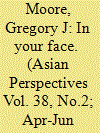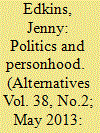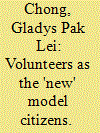| Srl | Item |
| 1 |
ID:
131258


|
|
|
|
|
| Publication |
2014.
|
| Summary/Abstract |
While China's rising power is certainly an important variable in Sino-Japanese relations, it cannot explain either why the Diaoyu/Senkaku Islands dispute broke out anew in the fall of 2012 or why the Chinese response was so strong. China read Japan's move to nationalize the islands as an in-your-face move designed to show disrespect for China and make Japan's sovereignty over the islands a fait accompli. In this article I borrow from Robert Putnam's notion of twolevel games to argue that there are two levels of face politics going on in this case: one between domestic actors in Japan and in China, the other between the two countries. A solution to the territorial dispute can only be found when both sides' "face needs" are recognized and met at both levels of analysis.
|
|
|
|
|
|
|
|
|
|
|
|
|
|
|
|
| 2 |
ID:
121199


|
|
|
|
|
| Publication |
2013.
|
| Summary/Abstract |
The faces of the missing are held aloft on placards in demonstrations or posted on walls in the aftermath of disappearances. They appear massed on the pages of newspapers and in the displays of genocide museums. Often nothing more than family snapshots given a public place, such images can be compelling. Although photographs of atrocity and war have frequently been discussed, little attention has been paid to these other images: images that do not show suffering but still seem, at least potentially, to be politically effective. How do these photographs work? What form of personhood do they instantiate and what politics do they point to? How are they different from other photographs? This article examines what might be special about a photograph, especially a photograph of a face, and how its political impact might be understood. Drawing on Lacanian psychoanalytic concepts of trauma and subjectivity, the article suggests that a photograph embodies in its very temporal structure a personhood that is inimical to contemporary structures of sovereign power. The destabilizing political potential of a photograph, like that of certain forms of literary text, could be understood as arising from its potential as an encounter with the trauma that inhabits sovereign power and sovereign subjectivity but that is generally concealed. The account presented offers an alternative approach to the analysis of the politics of a photograph and gestures toward other manifestations of personhood and politics.
|
|
|
|
|
|
|
|
|
|
|
|
|
|
|
|
| 3 |
ID:
175560


|
|
|
|
|
| Summary/Abstract |
While it is increasingly recognized that shame is a pernicious component of the experience of poverty, the stigma generally associated with social assistance provision is less marked with respect to China's Minimum Living Security System, also known as dibao. This enigma is explored and illuminated drawing on two streams of indigenous Chinese scholarship and qualitative fieldwork in eight villages in Shanxi province. Economic and political changes prioritizing economic growth and individual wealth have increased the shame associated with poverty, manifest as loss of face, low mian (status) and lack of lian (integrity). However, this shame does not transfer to dibao because the scheme has been transformed locally into a universal age supplement that partially fulfils the demands of filial piety and which is seen to reflect and contribute to guanxi (social influence).
|
|
|
|
|
|
|
|
|
|
|
|
|
|
|
|
| 4 |
ID:
104093


|
|
|
|
|
| Publication |
2011.
|
| Summary/Abstract |
Voluntary services and the word 'volunteer' have been discursively highlighted as something 'new' in China in the last few years. The large number of volunteers involved in relief work following the 5/12 Sichuan earthquakes, in the Beijing Olympics in 2008, and in the 2010 Shanghai Expo are examples of this yet understudied phenomenon. This article aims to examine volunteerism and its close relationship with the production of model citizens. It attempts to shed light on how China uses soft power - through appeal and attraction - in its governing strategies. Informed by Foucault's work on governmentality, this article aims to show how promotional strategies and training materials pertaining to volunteering programmes acted as governing strategies that invoked and produced specific power relationships through which the state governed its citizens. Taking the Beijing Olympic volunteer programme as a case to examine how a new model citizenry is produced, I trace three discourses: dream and glory, hosting a great Olympics, and not to 'lose face'. These discourses shape citizens' everyday lives; they help volunteers internalize and embody the ideal of a model citizen, and as such they are part of the organized practices through which subjects are governed in China.
|
|
|
|
|
|
|
|
|
|
|
|
|
|
|
|